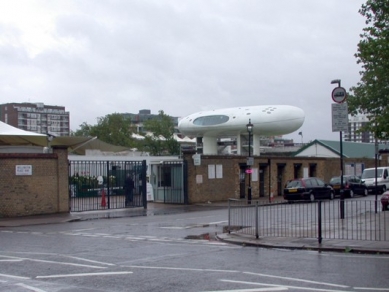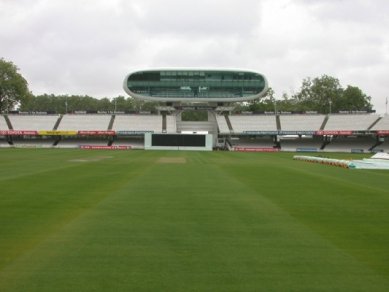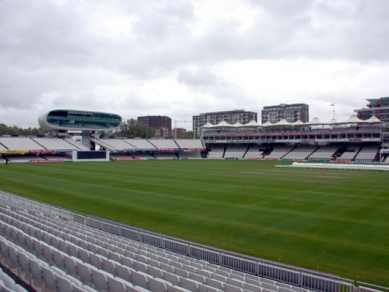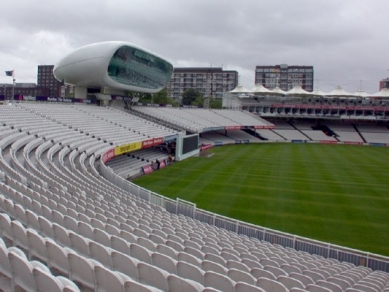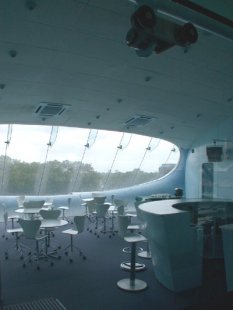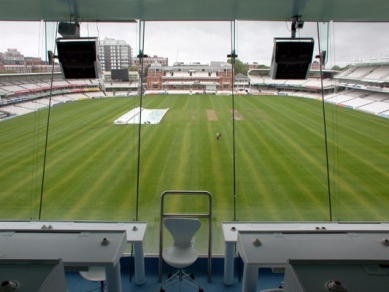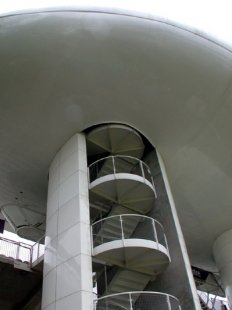
NatWest Media Centre

I attended a two-hour lecture on the history of a sport I still don’t understand, just to get into the most futurological building in London, whose strength lies in the relentless confrontation of modernity with tradition. The history of the Lord's cricket ground is breathtaking. Tennis was played here long before the famous Wimbledon, where the lawn is still cared for by the gardening masters from Lord's. There is one of the oldest covered tennis courts in existence, and the history of cricket is almost exclusively linked to this place. Most of the local buildings exude history, yet the National Cricket Association was not afraid to undergo a rejuvenating treatment. It all started in 1986 with Michael Hopkins (a year earlier he built his own office about half a mile from the stadium), who assembled the so-called Mound Stand. This was followed by constructions from Nick Grimshaw and David Morley. However, nothing can compare to what landed on the eastern side of the playing field in early May 1999. It was the very first public construction of the office Future Systems. Their portfolio until then consisted of cunningly designed interiors of shops or private villas. As Amanda Levete later said, they decided in the invited competition at the end of 1994 to put all their cards on one table.
The friendly UFO offers up to 270 seats in a modern transmission room, bar, and restaurant (Neue Zürcher Zeitung states the number is 120 and The Sunday Times 250. In reality, it comprises 120 journalists, 100 reporters, and 50 restaurant seats.). Journalists sit on white Series 7 rolling chairs by Arne Jacobsen at white cable-connected tables, and the entire room is upholstered in pale blue fabric. The Babyblue color is inspired by the color palette of the 1957 Ford Thunderbird, and the form is inspired by industrial design of compact cameras or protective helmets.
One thing I admire about Jan Kaplický is that he does not settle for the fact that his buildings cannot be realized by regular construction companies. He simply approaches companies that are further along in terms of construction. Shipyards or aviation companies can extract the maximum from traditional materials, and they use modern ones without fear and prejudice. 26 parts of the aluminum body of the building were created in the enormous hall of Pendennis shipyard, and the finished parts were simply assembled at the cricket ground. Each part measured 3x20 meters and weighed 4-6 tons. Jan Kaplický has a somewhat peculiar relationship with ecology. He enjoys using aluminum, which has one of the highest energy requirements needed for its production, but its disposal and further use is relatively easy. His studio calculated that 80% of the center can be recycled after its life cycle ends.
The construction faced difficulties, with the budget nearly doubled (from £3.5 million to £5.8 million, partly due to additional client requirements), but everything was eventually completed before the start of the World Cup. The Cyclopean eye above the cricket ground won the Stirling Prize the same year, defeating, for example, Foster's renovation of the Reichstag or the Stratford train station by the duo Wilkinson Eyre. Johnatan Glancey, the court critic of the Independent, called the media center “the most original and elegant building in Great Britain”.
The friendly UFO offers up to 270 seats in a modern transmission room, bar, and restaurant (Neue Zürcher Zeitung states the number is 120 and The Sunday Times 250. In reality, it comprises 120 journalists, 100 reporters, and 50 restaurant seats.). Journalists sit on white Series 7 rolling chairs by Arne Jacobsen at white cable-connected tables, and the entire room is upholstered in pale blue fabric. The Babyblue color is inspired by the color palette of the 1957 Ford Thunderbird, and the form is inspired by industrial design of compact cameras or protective helmets.
One thing I admire about Jan Kaplický is that he does not settle for the fact that his buildings cannot be realized by regular construction companies. He simply approaches companies that are further along in terms of construction. Shipyards or aviation companies can extract the maximum from traditional materials, and they use modern ones without fear and prejudice. 26 parts of the aluminum body of the building were created in the enormous hall of Pendennis shipyard, and the finished parts were simply assembled at the cricket ground. Each part measured 3x20 meters and weighed 4-6 tons. Jan Kaplický has a somewhat peculiar relationship with ecology. He enjoys using aluminum, which has one of the highest energy requirements needed for its production, but its disposal and further use is relatively easy. His studio calculated that 80% of the center can be recycled after its life cycle ends.
The construction faced difficulties, with the budget nearly doubled (from £3.5 million to £5.8 million, partly due to additional client requirements), but everything was eventually completed before the start of the World Cup. The Cyclopean eye above the cricket ground won the Stirling Prize the same year, defeating, for example, Foster's renovation of the Reichstag or the Stratford train station by the duo Wilkinson Eyre. Johnatan Glancey, the court critic of the Independent, called the media center “the most original and elegant building in Great Britain”.
The English translation is powered by AI tool. Switch to Czech to view the original text source.
1 comment
add comment
Subject
Author
Date
invenc
jirka
07.04.07 03:59
show all comments


